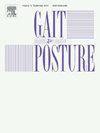A scoping review on the current state of sex- and gender-based analysis (SGBA) in standing balance research
IF 2.2
3区 医学
Q3 NEUROSCIENCES
引用次数: 0
Abstract
Background
Understanding sex and gender differences in standing balance is challenged by varied use of terminology and definitions. In addition, the use of sex- and gender-based analyses (SGBA) in standing balance research is unknown. This scoping review examined the frequency and type of SGBA, and the use of sex- and gender-based terminology in standing balance research published in the year 2020.
Methods
Eight databases were searched for peer-reviewed articles that quantitatively measured standing balance in adult humans using a biomechanical construct and were published in 2020. Two independent reviewers screened abstracts and extracted data with a third reviewer resolving conflicts. In accordance with sex and gender equity in research (SAGER) guidelines, data extraction focused on participant demographics, inclusion and type of SGBA, consistency of sex and gender terminology, alignment with operational definitions (e.g., female used to describe sex), and sex and gender data collection methods. Absolute and relative values across all articles and within collaboratively created categories of participant groups were calculated.
Results
Of the 366 articles in the analysis, 20 % included sex and/or gender in the statistical analyses of which 50 % conducted SGBA. Consistent terminology aligned with this study’s definitions of sex and gender was found in 12 % of all articles, whereas 40 % used labels consistently without assigning them to sex or gender, ∼20 % used inconsistent or unaligned terminology, and 7 % did not report sex or gender. No articles included more than two options for sex or gender, and very few included self-reporting by participants (3 % for sex, 1 % for gender) or clearly described how sex (3 %) or gender (1 %) data were collected.
Conclusions
Small changes to the collection and reporting of sex and gender, and more SGBA in standing balance research could drastically improve the inclusivity and accuracy of standing balance assessment in research and clinical settings.
站立平衡研究中性别和基于性别的分析(SGBA)的现状综述
理解站立平衡中的性别和性别差异受到各种术语和定义使用的挑战。此外,在站立平衡研究中使用性别和基于性别的分析(SGBA)是未知的。这一范围审查审查了SGBA的频率和类型,以及在2020年发表的站立平衡研究中使用的性别和基于性别的术语。方法在8个数据库中检索同行评议的文章,这些文章使用生物力学结构定量测量了成年人的站立平衡,并于2020年发表。两名独立审稿人筛选摘要并提取数据,第三名审稿人解决冲突。根据研究中的性别和性别平等(SAGER)指南,数据提取侧重于参与者人口统计、SGBA的纳入和类型、性别和性别术语的一致性、与操作定义的一致性(例如,女性用于描述性别)以及性别和性别数据收集方法。计算了所有文章和协作创建的参与者群体类别中的绝对值和相对值。结果在分析的366篇文章中,20 %在统计分析中包含性别和/或性别,其中50 %进行了SGBA。所有文章中有12% %的术语与本研究的性别和性别定义一致,而40% %的文章使用了一致的标签而没有指定性别或性别,20% %的文章使用了不一致或未对齐的术语,7% %的文章没有报告性别或性别。没有文章包含两个以上的性别或性别选项,很少有文章包含参与者的自我报告(性别为3 %,性别为1 %)或明确描述如何收集性别(3 %)或性别(1 %)数据。结论在站立平衡研究中对性别和性别的收集和报告进行微小的改变,以及在站立平衡研究中增加SGBA,可以极大地提高研究和临床环境中站立平衡评估的包容性和准确性。
本文章由计算机程序翻译,如有差异,请以英文原文为准。
求助全文
约1分钟内获得全文
求助全文
来源期刊

Gait & posture
医学-神经科学
CiteScore
4.70
自引率
12.50%
发文量
616
审稿时长
6 months
期刊介绍:
Gait & Posture is a vehicle for the publication of up-to-date basic and clinical research on all aspects of locomotion and balance.
The topics covered include: Techniques for the measurement of gait and posture, and the standardization of results presentation; Studies of normal and pathological gait; Treatment of gait and postural abnormalities; Biomechanical and theoretical approaches to gait and posture; Mathematical models of joint and muscle mechanics; Neurological and musculoskeletal function in gait and posture; The evolution of upright posture and bipedal locomotion; Adaptations of carrying loads, walking on uneven surfaces, climbing stairs etc; spinal biomechanics only if they are directly related to gait and/or posture and are of general interest to our readers; The effect of aging and development on gait and posture; Psychological and cultural aspects of gait; Patient education.
 求助内容:
求助内容: 应助结果提醒方式:
应助结果提醒方式:


